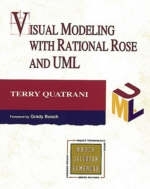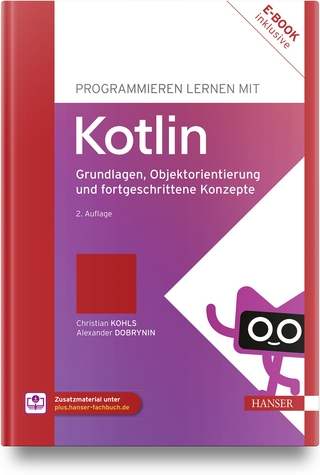
Visual Modeling with Rational Rose and UML
Addison Wesley (Verlag)
978-0-201-31016-0 (ISBN)
- Titel ist leider vergriffen;
keine Neuauflage - Artikel merken
As software application development becomes more complex, the benefits of developing a comprehensive "blueprint" enabling developers to visualize the complete scope of a project increase substantially. Three elements are needed to successfully diagram and visualize a software system--a process, a notation, and a modeling tool. This timely new book introduces the reader to three of the most popular and influential such elements; the Rational Objectory process, the Unified Modeling Language (UML), and Rational Rose. With the practical direction offered in this book, you will be able to specify, visualize, document, and create software solutions. Throughout the book, a simplified case study (a course registration system for a university) is employed to illustrate the analysis and design of an application. The presentation is structured to allow concentration on the specifics of modeling the domain without getting bogged down in unnecessary detail. This efficient approach to teaching visual modeling and the application of UML enables you to focus on learning to apply an iterative and incremental process to analysis and design.Other highlights include: *an examination of system behavior from a use case approach *a discussion of the concepts and notations used for finding objects and classes *an introduction to the concepts and notation needed to create and document a system's architecture *a review of the iteration planning process 0201310163B04062001
Terry Quatrani, IBM Rational’s UML Evangelist, is responsible for training and transitioning Fortune 500 companies to object technology and for preaching the visual modeling gospel of Grady Booch, Jim Rumbaugh, and Ivar Jacobson. She has spent twenty-one years developing and deploying large software systems. Formerly at GE, she was founding consultant for the Lockheed Martin Advanced Concepts Center.
(Each chapter concludes with a Summary.)
Foreword.
Preface.
1. Introduction.
What Is Visual Modeling?
The Triangle for Success.
The Role of Notation.
History of the UML.
The Role of Process.
What Is Iterative and Incremental Development?
The Rational Objectory Process.
The Rational Rose Tool.
2. Beginning a Project.
Defining the Right Project.
Eastern State University (ESU) Background.
Risks for the Course Registration Problem.
ESU Course Registration Problem Statement.
3. Creating Use Cases.
System Behavior.
Actors.
Use Cases.
Use Case Relationships.
Use Case Diagrams.
4. Finding Classes.
What Is an Object?
State, Behavior, and Identity.
What Is a Class?
Stereotypes and Classes.
Discovering Classes.
Documenting Classes.
Packages.
Objects and Classes in the ESU Course Registration Problem.
Class Diagrams.
5. Discovering Object Interaction.
Use Case Realization.
Documenting Scenarios.
Sequence Diagrams.
Sequence Diagrams and Boundary Classes.
Complexity and Sequence Diagrams.
Collaboration Diagrams.
Why Are There Two Different Diagrams?
Sequence Diagram for the ESU Course Registration System.
6. Specifying Relationships.
The Need for Relationships
Association Relationships
Aggregation Relationships
Association or Aggregation?
Naming Relationships.
Role Names.
Multiplicity Indicators.
Reflexive Relationships.
Finding Relationships.
Relationships in the ESU Course Registration Problem.
Package Relationships.
Package Relationships in the Course Registration Problem.
7. Adding Behavior and Structure.
Representing Behavior and Structure.
Creating Operations.
Documenting Operations.
Relationships and Operation Signatures.
Creating Attributes.
Documenting Attributes.
Displaying Attributes and Operations.
Association Classes.
8. Discovering Inheritance.
Inheritance.
Generalization.
Specialization.
Inheritance Trees.
Single Inheritance versus Multiple Inheritance.
Inheritance versus Aggregation.
9. Analyzing Object Behavior.
Modeling Dynamic Behavior.
States.
State Transitions.
Special States.
State Transition Details.
State Details.
10. Checking the Model.
Why Homogenize?
Combining Classes.
Splitting Classes.
Eliminating Classes.
Consistency Checking.
Scenario Walk-Through.
Event Tracing.
Documentation Review.
11. Designing the System Architecture.
The Need for Architecture.
The Architecture Team.
The “4+1” View of Architecture.
The Logical View.
The Component View.
The Process View.
The Deployment View.
The Use Case View.
12. Building the Iterations.
The Iteration Planning Process.
Designing the User Interface.
Adding Design Classes.
The Emergence of Patterns.
Designing Relationships.
Designing Attributes and Operations.
Designing for Inheritance.
Coding, Testing, and Documenting the Iteration.
Using Reverse Engineering to Set the Stage for the Next Iteration.
Appendix A.
Appendix B.
Glossary.
Index. 0201310163T04062001
| Erscheint lt. Verlag | 14.1.1998 |
|---|---|
| Verlagsort | Boston |
| Sprache | englisch |
| Gewicht | 375 g |
| Themenwelt | Mathematik / Informatik ► Informatik ► Programmiersprachen / -werkzeuge |
| Informatik ► Software Entwicklung ► Objektorientierung | |
| Informatik ► Software Entwicklung ► UML | |
| ISBN-10 | 0-201-31016-3 / 0201310163 |
| ISBN-13 | 978-0-201-31016-0 / 9780201310160 |
| Zustand | Neuware |
| Haben Sie eine Frage zum Produkt? |
aus dem Bereich


